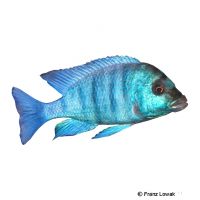Phenochilus Gissel (Placidochromis phenochilus 'Gissel')
| Phenochilus Gissel Placidochromis phenochilus 'Gissel' | |
|---|---|
| Name | Phenochilus Gissel |
| Name Lat. | Placidochromis phenochilus 'Gissel' |
| Synonym | Placidochromis gisseli |
| Family | Cichlids |
| Family lat. | Cichlidae |
| Order | Cichlids |
| Order lat. | Cichliformes |
| Origin | Lake Malawi |
| Habitat | Sandy zone |
| Diet | Carnivore |
| pH | 7.5-8.8 |
| Behavior | Peaceful |
| Keeping | Harem |
| Care Level | Moderate |
| Reproduction | Mouthbrooder |
| Breeding | Moderately difficult |
| Life Span | 5-8 years |
| Protection | No |
| Metric Units | |
| Size | 14-16 cm |
| Temperature | 24-28 °C |
| Hardness | 10-25 °dH |
| Aquarium | ~ 350 l |
| US Units | |
| Size | 5.5"-6.3" |
| Temperature | 75-82 °F |
| Hardness | 178-445 ppm |
| Aquarium | ~ 100 gal |
Distribution and habitat
The Placidochromis phenochilus "Gissel" occur exclusively (endemic) in Lake Malawi. This site variant of Placidochromis phenochilus is native to the east coast at"Gome Rocks". They mainly stay in the rocky transition zone with sandy bottoms down to a depth of 25 meters.
Maintenance
The aquarium setup should have rock structures reaching to the water surface with plenty of hiding places (crevices, caves, shelters), with roots and free sand areas, as well as plenty of free swimming space
No ammonia, ammonium and nitrite should be detectable, the nitrate value should not exceed 100 mg/l. To ensure the water quality and oxygen content, a filter and heater adapted to the aquarium size is required, as well as lighting for the species-appropriate day-night rhythm of the animals.
Diet
They feed mainly on invertebrates and microorganisms. The food supply consists of small live foods, such as cyclops, daphnia, artemia, mosquito larvae, etc., which are also accepted without problems in frozen form, or a commercially available, frozen special food mix for cichlids. Also protein-rich dry food for cichlids in the form of pellets, granules or flakes is usually accepted without problems.
Regular and varied feeding promotes health and increases resistance. Only as much should be fed as is eaten within a few minutes.
Behaviour and compatibility
They are relatively peaceful and should be kept in a harem, one male with several females. Keeping several harems is only recommended in a larger and richly structured tank. A socialization with other small cichlids from Lake Malawi, such as Lethrinops, Aulonocara or Copadichromis is well possible.
Basically, only compatible fish species with similar demands on water condition and water temperature may be socialized.
Sex dimorphism
The sexes are difficult to distinguish. The females are usually slightly smaller than the males, which have a pointed dorsal fin and are slightly more strongly colored than the females.
Reproduction and breeding
They are maternal mouth breeders. The female usually spawns on a shallow rock. After the male fertilizes the eggs, she immediately takes the female into her throat pouch for mouth brood care and keeps the fry in her throat pouch even after hatching. After about 3-4 weeks, the fry are released and brood care ends. Throughout brood care, the female does not consume food. The fry grow very slowly.
Fry must be fed several times a day with special rearing food (Artemia nauplii). In a community tank breeding is hardly possible, because the fry are easy prey.
Important
In their natural environment, they accompany sand boars, such as Lethrinops or Fossochromis, as they scour the soil for food, and they feed on the microorganisms that are stirred up.
The well-being of the fish should be checked regularly. Temperature should be checked daily, pH, hardness and nitrate levels at least fortnightly. A regular partial water change is recommended, even if the pollutant load has not yet reached the upper limit. Sudden changes in water quality should be avoided. Newly introduced fish must be accustomed slowly to the water in the aquarium.
Further literature can be found in your pet store.
References
Text: petdata; Image: Franz Lowak
Source: BMELV (1998): Tierschutzgutachten - Haltung von Zierfischen (Süßwasser); ENGELMANN (2005): Zootierhaltung - Tiere in menschlicher Obhut: Fische, Verlag Harri Deutsch; BAENSCH & RIEHL (2004): Aquarienatlas Bd. 2, Mergus Verlag
- Gemäß § 21 Abs. 5 Tierschutzgesetz idgF
